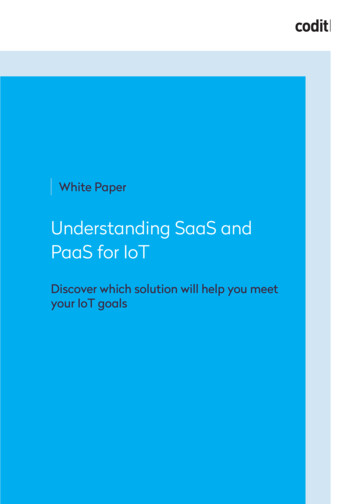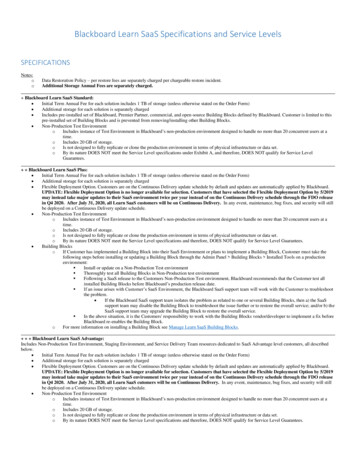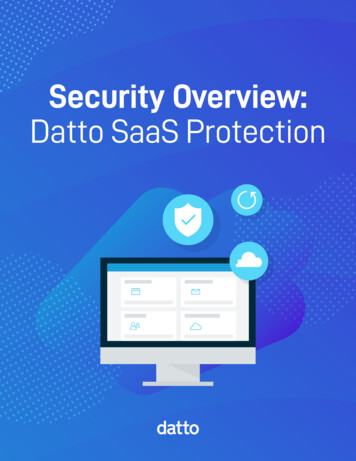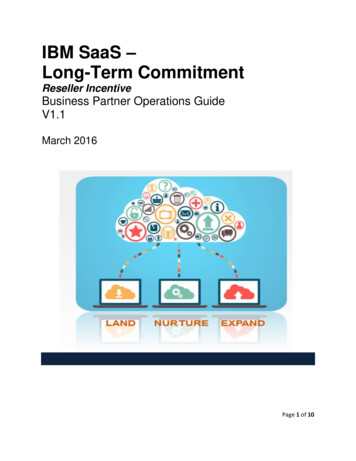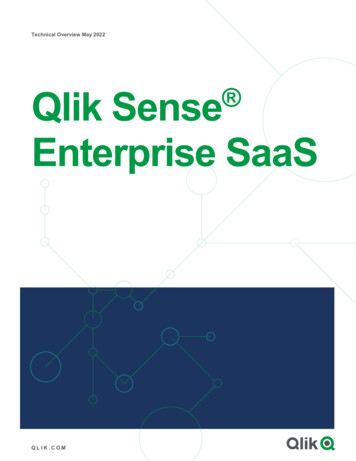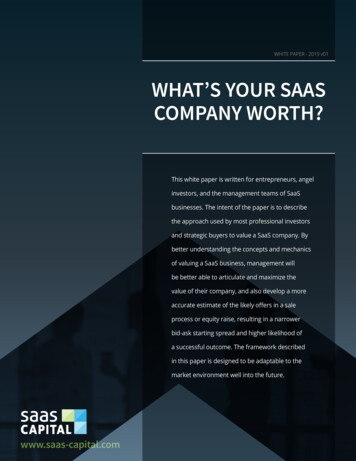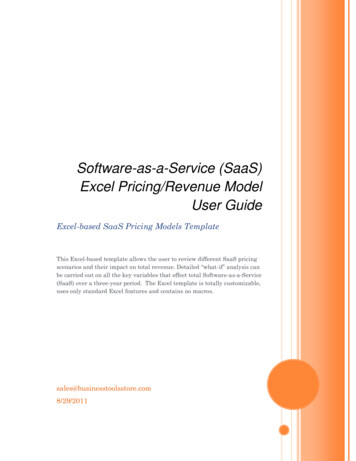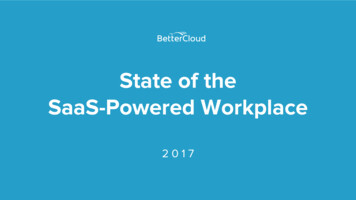
Transcription
State of theSaaS-Powered Workplace2017
2017 State of theSaaS-Powered WorkplaceThe workplace will never be the same again.Swiftly and surely, the world is shifting to Software-as-a-Service (SaaS). It’s becoming the de facto delivery model forcore business applications.But how is SaaS transforming the way we work? Over the past six months, we surveyed1,800 IT professionals to get a deeper understanding of this new workplace,where SaaS applications serve as the backbone of productivity.The data revealed astonishing findings. SaaS is a double-edged sword. And while itbrings incredible benefits, it also creates formidable challenges that are taking theroles and responsibilities of IT to new extremes.This report provides a glimpse into the future. Our respondents—the mostforward-thinking, cutting-edge IT innovators on the front lines—have told us exactly whatthey’re experiencing in the modern workplace.And now we’re sharing this knowledge with the rest of the world: the good, the bad, andthe ugly of SaaS, and how IT can thrive in it.David PolitisFounder & CEO, BetterCloudSOURCE: IDC Market Analysis Perspective
Why is BetterCloud theauthority on the shift to SaaS?
2017 State of theSaaS-Powered WorkplaceWe have a view ofthe market that noone else does.We routinely interview and survey thousands of ITprofessionals responsible for SaaS deployment and100,000 peoplesubscribe to our daily newsletter,The BetterCloud Monitor, for the latestnews on IT and SaaS.management. These insights allow us to get an in-depthlook at major trends in the industry.Our research has been featured in dozens of keynotes,investor presentations, and publications like:1,200 peoplebelong to BetterIT, our new Slack communityfor forward-thinking IT professionals.
2017 State of theSaaS-Powered WorkplaceDemographicsBY ROLE1,827 peopleWe surveyedacross a variety of IT roles and organization sizes30%VSB/SMB: 1-1000 MM/ENT: 1001 Director33%BY SIZE10%Individual ContributorCXO25%Manager3%VP20%MM/ENT80%VSB/SMB
The world is shifting to SaaS no matter how you look at it.Have we reached thetipping point?
2017 State of theSaaS-Powered Workplace"There hasn't been an on-premises software company fundedsince 2007. You have no choice. It's all going to be SaaS."— R. "Ray" Wang, principal analyst at Constellation ResearchVendors are no longerbuilding on-premsoftware.
2017 State of theSaaS-Powered WorkplaceVendors areeither building newSaaS products.
2017 State of theSaaS-Powered Workplace or acquiringSaaS companies.
2017 State of theSaaS-Powered WorkplaceSaaS is now the system of record.LEGACY TECHNOLOGYSaaS COMMUNICATIONEMAILCODE
How fast is theSaaS market growing?
2017 State of theSaaS-Powered WorkplaceThe cloud shift rate through2020 for SaaS is 3x faster thanPaaS and 2x faster than IaaS.SaaS 37% 69 billion shifted from legacy spend tocloud services in 2016.IaaS 17%PaaS 10%Cloud Shift Rate (2016-2020)Source: Gartner Says by 2020 "Cloud Shift" Will Affect More Than 1 Trillion in IT Spending
2017 State of theSaaS-Powered WorkplaceWorldwide Public Cloud Services Forecast(Billions of urce: Gartner Says Worldwide Public Cloud Services Market to Grow 18 Percent in 2017
What does SaaS adoptionlook like in the trenches?
2017 State of theSaaS-Powered WorkplaceThe number of SaaS appsorganizations use is rising.81216201720162015Average # of SaaS Apps Used Per OrganizationSources: Trends in Cloud IT: Dissecting Adoption Across Thousands of Organizations (2015) Growing Pains: Latest Research Shows IT Struggling to Meet SaaS Application Demand (2016)
2017 State of theSaaS-Powered WorkplaceCompanies will be runningpurely on SaaS soon.73% of organizations say nearly all theirapps will be SaaS by 2020.Percentage of orgs estimating when 80% of their business apps will be SaaS
2017 State of theSaaS-Powered WorkplaceLarge companies aren’t as farbehind as you might think.75% of SMBs and 69% of MM/ENTssay the majority of their apps willbe SaaS by 2020.Percentage of orgs estimating when 80% of their business apps will be SaaS
2017 State of theSaaS-Powered WorkplaceVendor Vision & RoadmapWhen IT professionalspurchase SaaSapplications, these arethe criteria they caremost about.Reporting & Analytics7%Disaster Recovery Plan12%Data Center me Guarantees13%15%Admin & Mgmt CapabilitiesCustomer Support23%Integrations30%Ease of UseSecurityCost6%24%38%47%59%*Respondents were asked to select their top 3 criteria
So what does all this mean?A new type of workplace isstarting to emerge.
2017 State of theSaaS-Powered Workplace38% of companies arerunning almost entirelyon SaaS.Percentage of orgs estimating when 80% of their business apps will be SaaS
These areSaaS-Powered Workplaces.
2017 State of theSaaS-Powered WorkplaceAll they really need is adecent internet connection.
2017 State of theSaaS-Powered WorkplaceThey use anaverage of34 apps2.1x more than theaverage workplace
2017 State of theSaaS-Powered WorkplaceCompared to the averageorganization, they are:52%more likely tosay SaaS helpsattract better talent7%more likely tosay SaaS cuts costs8%more likely tosay SaaS bolsterscommunication31%more likely tosay SaaS improvesemployee satisfaction
2017 State of theSaaS-Powered Workplace86%of end userssay SaaS applications help themsucceed more than desktopalternatives.Source: Trends in Cloud IT (2016)
2017 State of theSaaS-Powered Workplace48.6% 30%25%reductionin emailfewerscheduledmeetingsincrease inCSAT-- Mike Heim, CIO,WhirlpoolSOURCE: Zendesk customer case study(Acquia)according to SlackSurvey ResultsSOURCE: Slack surveySOURCE: G Suite, “How one of America’s iconiccorporations feels like a startup again”(customer satisfaction)
The benefits to users are clear.94% of IT survey respondents also reportedsignificant benefits from adopting SaaS.But it means newresponsibilities for IT.
2017 State of theSaaS-Powered WorkplaceToday, your business runs on SaaS.SaaS has moved from fringe to mission critical.It’s core to the business.
2017 State of theSaaS-Powered Workplace5-10 years ago,SaaS apps were inthe shadows.SaaS apps flew under IT’s radar. Line ofbusiness or operations staff oftencircumvented IT to purchase and deploySaaS apps themselves. Consequently, ITbegan losing control over theirenvironment.“Rogue SaaS is Aliveand Kicking, IT Leaders”(2010)“10 Hard Truths ITMust Learn to Accept”“SaaS Purchases OftenHappen Outside IT’sRealm” (2011)“SaaS Apps Being Deployedby Business Units, Not IT”(2007)“IT concession No. 2: You’ve lostcontrol over how your company usestechnology.” (2011)“Business Users Bypass ITand Go Rogue to the Cloud”(2014)
2017 State of theSaaS-Powered WorkplaceFor SaaS to serve asthe system of recordeffectively, IT mustregain control.SaaS apps are no longer simple “out of the box” solutions.Businesses want them to be integrated and customized,with security wrapped around them. They expect identityto be merged together and centralized. In order to unlockthe full value of SaaS, IT must be closely involved in therollout and management of SaaS apps.
2017 State of theSaaS-Powered Workplace2001Consultants, not IT,lead software implementation“How to Install ERP Without IT”1998-1999-TechRepublic2002NetSuite and Salesforceare foundedIT regains control“CIOs Take Back Control of EnterpriseProjects from Consultants” -CIO2004Salesforce IPOs1990IT controls on-prem softwareWe’ve comefull circle.2017IT starts to control SaaS“The CIO Must Take Charge of theOrganization’s Application Portfolio”2007Shadow IT emerges; NetSuite IPOs“SaaS Apps Being Deployed by Business Units,Not IT”- TechTarget2009SaaS creates problems for IT-IBM Security Intelligence”The Challenges of Managing SaaS Projects” -CIO20162011IT changes its approach“Parthenon-EY’s research indicates that CIOsare feeling a loss of control, but are beginningto find ways to take that control back.” -CIOs andTheir Shifting Relationship with SaaSIT starts losing control2015“Is SaaS a Threat to CIO Control?” -Information AgeIT admits hard truths2014“CIOs Admit They AreConcerned About SaaSManagement”-Computer WeeklyIT increasingly loses control”Business Users Bypass IT and GoRogue to the Cloud” -ComputerWorld
2017 State of theSaaS-Powered Workplace% SaaS Apps Managed by IT Today88%74%42%VSBsSMBSMM/ENTSIT is starting toadminister, own, andmanage more SaaSapplications thanthey ever have.
2017 State of theSaaS-Powered WorkplaceSaaS creates new challenges for IT.And these challenges only become larger and more complex in the SaaS-Powered Workplace.57%81%believe their jobs are becomingmore difficult as theirorganization adopts more SaaSapplications.say they experience a significantchallenge with managing SaaSapplications.
What are the biggestchallenges facing IT in theSaaS-Powered Workplace?
2017 State of theSaaS-Powered WorkplaceCHALLENGE #1Delegating AdminPrivilegesSaaS-Powered Workplaces areA recent global security survey found that “theimplementation of delegation — the capability toimplement a least-privileged model of admin activity inwhich administrators are only given sufficient rights todo their job” was one of the most crucial practicesaround critical account management in organizations.In the SaaS-Powered Workplace, delegating granularadmin rights is cumbersome at best and impossible atworst. And with vendors constantly introducing newpermissions, it can be difficult to keep up.Source: CIO3.5x more likelyto say that delegating admin privileges isa challenge.
2017 State of theSaaS-Powered WorkplaceCHALLENGE #2UnderstandingExternal AccessGiven that the freelancer economy is on the rise -40% of America’s workforce will be freelancers by2020 — managing external access correctly is anincreasingly important challenge for IT.“Cumulatively, security incidents stemming fromnegligent and careless employees or contractorscost the most money. Organizations spent about 2.3 million annually dealing with the fallout fromsuch incidents, at an average of about 207,000per incident.”Source 1: QUARTZ; Source 2: InformationWeek DARKReadingSaaS-Powered Workplaces are2.9x more likelyto say that understanding external accessis a challenge.
2017 State of theSaaS-Powered WorkplaceCHALLENGE #3Automating RepetitiveProcesses Across AppsOur research showed that IT has: 12 steps in their average onboarding process* 28 steps in their average offboarding process*And that’s just for G Suite alone. When youconsider how many other apps and repetitive stepsare involved in onboarding and offboardingprocesses, it makes sense that this is a majorchallenge for IT.*organizations over 5,000 seatsSource: Trends in Cloud ITSaaS-Powered Workplaces are2.5x more likelyto say that automating repetitive tasksacross apps is a challenge.
2017 State of theSaaS-Powered WorkplaceCHALLENGE #4Managing Users andAssets Across AppsWhen you think about how many data objectsexist in a multi-SaaS environment, there is animpressive amount of sprawl. There are users,memberships, calendars, permissions, files, etc.If you multiply this by dozens of apps and tens,hundreds, or thousands of users, it’sunderstandable why managing users andassets across apps is such a challenge.SaaS-Powered Workplaces are2x more likelyto say that managing users and assetsacross apps is a challenge.
To adapt, IT must evolvein 3 main areas.
2017 State of theSaaS-Powered Workplace1 Roles and Responsibilities“Success lies in breaking away from theclassical decentralized ownership approachwhere the ‘predominate user’ engages with thevendor, pays the bills, and calls all the shots. But whywould anyone want to give up his/her agility and letthe CIO organization in? Because ultimately,organizations need to achieve cross-companyprocess agility, and that cannot happen unless youengage someone with an overarching view tooptimize at that level.”— Yvonne Wassenaar, CIO, New RelicSource: “The Role of CIO in the Cloud-First World”CIOs must focus on adding valuable services tocomplement SaaS usage, according to Gartner.“The office of the CIO should focus on becominga cloud brokerage, offering value-addedcapabilities, including help desk/supportfor cloud SaaS solutions, integration skills,and procurement and contractmanagement skills for cloud usage.”Source: “CIOs Flip for Cloud SaaS”
2017 State of theSaaS-Powered Workplace2Processes“As a modern CIO, your impact needs to be quickand meaningful. Shifting to the cloud and adoptingSaaS solutions allows CIOs to be agile, flexible,make more informed business decisionswith quicker access to data and analytics,and adopt modern tools that helpemployees to be more productive andcustomers to have a better experience The longer companies wait to make this fulltransition, the further they will fall behind."— Tom Keiser, CIO, ZendeskBy 2018, about half of companies (46%)say they will need greater automation tohandle the volume of tasks beinggenerated. By 2020, nearly 9 out of 10companies (86%) will hit that breaking point.Why? Because nearly half (48%) say that worklevels have increased by 20% or more in the lastyear. And routine tasks are taking up preciousresources: 91% of executives say their skilledemployees spend too much time on admin tasks.Source: ServiceNow State of Work Report 2017
2017 State of theSaaS-Powered Workplace3Budgets“CIOs are increasingly expected to do more and those that dowill be given a ‘justified’ budget to enable digitaltransformation, said Isaac Sacolick, principal at consultingfirm StarCIO and a former CIO ‘[T]hey need to be leaving theenterprise not only with the ability to grow and enable newcustomer experiences, but they've got to do it in a way that'sgoing to end up with a less expensive IT footprint.’The way that CIOs are going to achieve this is byutilizing the cloud, SaaS and more nimble enterpriseservices that are better interconnected."Source: “Gartner Cuts 2017 IT Spending Forecast, Sees Shift to ‘Digital Business’”“Historical approaches to IT funding and themechanisms used to prioritize and tracktechnology spending do not support thesechanges. Project-based fundingcreates rigidities and delaysbecause it is tied to annualbudgeting processes and cannotaccommodate the iteration anduncertainty associated with digitalinvestments delivered as products.”Source: InformationWeek “CIOs Should Make 5 Changes to ITFunding in an Age of Digitization”
2017 State of theSaaS-Powered Workplace5 Key Takeaways1SaaS is a runaway train that’sshowing no signs of stopping.Companies use 16 SaaS apps on average today,up 33% from last year. 73% of organizations saynearly all (80% ) of their apps will be SaaS by2020.2As a result, a new type ofworkplace called theSaaS-Powered Workplace isemerging. 38% of companies are alreadyrunning almost entirely on SaaS. This newenterprise is the SaaS-Powered Workplace.3It creates incredible benefits likebolstering communication, cutting costs, and improvingemployee satisfaction.it also creates new challenges4Butfor IT.These challenges only become more amplifiedin the SaaS-Powered Workplace.5To adapt to this new enterprise,IT must change the way it does itsjob. IT needs to rethink its roles, responsibilities,processes, and budgets.
About BetterCloudSubscribe to our daily newsletterBetterCloud is the first multi-SaaS managementplatform, enabling IT to centralize, orchestrate, andfor the latest IT and SaaS news.operationalize day-to-day administration and controlacross SaaS applications. Every day, thousands ofcustomers rely on BetterCloud to centralize data andcontrols, surface operational intelligence, orchestrateJoin our community,complex actions, and delegate custom administratorprivileges across SaaS applications.and talk tech with 1,200 IT professionals.
Cloud Shift Rate (2016-2020) PaaS 10% IaaS 17% The cloud shift rate through SaaS 37% 2020 for SaaS is 3x faster than PaaS and 2x faster than IaaS. . Source: Trends in Cloud IT (2016) 2017 State of the SaaS-Powered Workplace 48.6% reduction in email according to Slack Survey Results SOURCE: Slack survey 25% increase in



